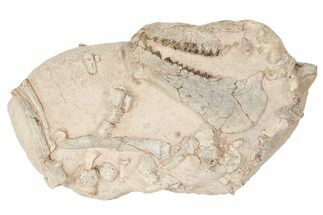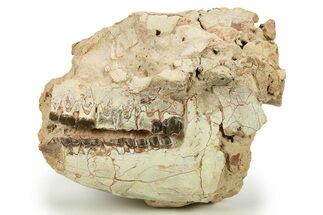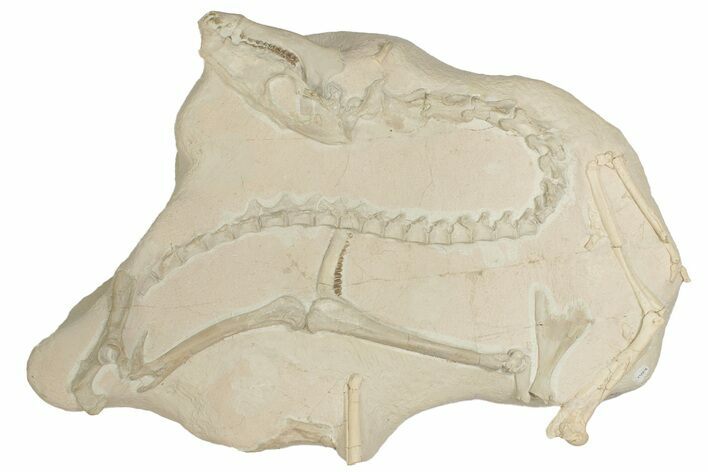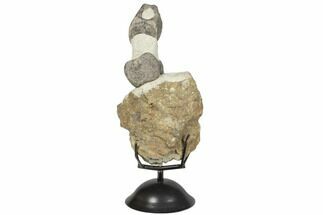This Specimen has been sold.
27" Articulated Fossil Camel (Poebrotherium) - Wyoming
This is a fascinating plate of naturally associated camelid (Poebrotherium sp.) bones that come from the White River Formation of Wyoming. It is Oligocene in age, or approximately 30 to 34 million years old. The skull and spine are naturally articulated and have been left in the position in which they were found. All of the teeth on this entire specimen are natural, with most in pristine condition! These bones were found associated with two hind legs (each from a different camelid), a partial pelvis, the left side of a mandible, a partial cannon bone, partial skull, several phalanges, and a partial scapula. The largest leg, scapula, pelvic bone, vertebrae (spine), and skull are all from the same animal. It's possible that the smaller leg, mandible, upper skull section, phalanges, and partial cannon bone are all from one additional camelid, however they're most likely from multiple other animals.
The color variation between the bones indicates that some of the bones were exposed to the sun for some time. This may have been how the skull and spine were found in the first place, following the discovery of the exposed smaller hind leg. The rock was removed in pieces, requiring crack repair as the bone-filled rock was pieced back together. The overlying rock was then meticulously prepped away to reveal this gorgeous specimen! A false rock has been added around the periphery, underside, and within gaps where the fragile, fine-grained claystone turned to dust.
Gap fill was placed in spots where the bones had become fragmented to ensure their stability. All of the vertebrae present are natural and have not been composited. Almost every vertebra required some minor gap fill restoration, however none of the centrums or processes have undergone any extensive restoration or reconstruction. The skull is in phenomenal condition, with little to no compression and minimal fragmentation of the bone. There is a repaired crack through the anterior end of the skull which runs through the nasal bone, maxilla, and mandible. The superior-posterior (upper crest) portion of the skull has undergone some restoration as well.
Measurements:
Entire Plate - 27" long, 19" wide, 5" thick
Skull - 7.8" long
Spine - 29" long
Largest Femur - 7.6" long
Largest Tibia - 8.3" long
Scapula - 4.6" long
The color variation between the bones indicates that some of the bones were exposed to the sun for some time. This may have been how the skull and spine were found in the first place, following the discovery of the exposed smaller hind leg. The rock was removed in pieces, requiring crack repair as the bone-filled rock was pieced back together. The overlying rock was then meticulously prepped away to reveal this gorgeous specimen! A false rock has been added around the periphery, underside, and within gaps where the fragile, fine-grained claystone turned to dust.
Gap fill was placed in spots where the bones had become fragmented to ensure their stability. All of the vertebrae present are natural and have not been composited. Almost every vertebra required some minor gap fill restoration, however none of the centrums or processes have undergone any extensive restoration or reconstruction. The skull is in phenomenal condition, with little to no compression and minimal fragmentation of the bone. There is a repaired crack through the anterior end of the skull which runs through the nasal bone, maxilla, and mandible. The superior-posterior (upper crest) portion of the skull has undergone some restoration as well.
Measurements:
Entire Plate - 27" long, 19" wide, 5" thick
Skull - 7.8" long
Spine - 29" long
Largest Femur - 7.6" long
Largest Tibia - 8.3" long
Scapula - 4.6" long
Poebrotherium (meaning "grass-eating beast") is an extinct camelid that roamed North America between the Eocene and Miocene epochs. They were smaller than modern camels, about the same size as a modern sheep, and fit in the place of deer or gazelles in the White River fauna. Despite their name, it is believed that grass was likely not their primary food source but they were instead browsers, feeding on various foliage and berries. Based on bite marks in bones, they were likely preyed on by Archaeotherium, an extinct boar-like entelodont which was also prevalent throughout the White River ecosystem.
SPECIES
Poebrotherium sp.
LOCATION
Wyoming
FORMATION
White River Formation
SIZE
Entire Specimen: 27 x 19 x 5", Weight: 61.5 lbs
CATEGORY
SUB CATEGORY
ITEM
#210177
We guarantee the authenticity of all of our specimens.
 Reviews
Reviews
































